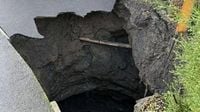On Sunday morning, September 21, 2025, residents of Darwen, Lancashire awoke to a scene that was both dramatic and, for some, grimly predictable: a massive sinkhole, estimated at 50 feet deep, had opened up in the middle of Greenfield, a new housing estate just off Pole Lane. The collapse of the road surface triggered a swift and sweeping emergency response, with police cordoning off the area and fire crews, including a drone unit, arriving promptly at 7:21am to assess the damage and ensure public safety.
The sudden appearance of the sinkhole forced the evacuation of seven homes on the estate, leaving families scrambling to find shelter and answers. According to LancsLive, residents were told to leave their properties as the ground beneath them gave way, with one local sharing on social media, "It's going under our garden and both houses are being evacuated. The fire brigade said they've never seen one this big." The sense of urgency was palpable, as neighbors watched emergency services descend on their quiet street.
Heavy rainfall the previous day had already left the region waterlogged and roads flooded. Many locals suspected the deluge played a role in the disaster. John Grimshaw, a regular dog walker on Pole Lane, told LancsLive, "There was a hell of a lot of rain yesterday and with all this construction going on you can imagine how it might have caused problems. As far as I know most of these houses were built about five years ago. We have seen a few problems with drainage round here so I do think all that rain yesterday is probably what’s caused it."
But for many, the sinkhole was less a freak act of nature and more an accident waiting to happen. Greenfield, after all, was built on land with a history of mining—a fact that had sparked warnings well before the first brick was laid. Residents have long voiced concerns about the risks of constructing new homes atop former coal mine shafts and areas known for drainage issues. As one longtime local from Rudyard Drive told The Sun, "We are not surprised at all. There has been issues with this land for years and years in terms of drainage and coal mine shafts underground. It seemed to us they just wanted to build houses wherever they can in Darwen and we are not surprised. I just feel really sorry for the people affected and I hope they can find somewhere to go."
Social media quickly filled with pointed commentary. One Facebook user quipped, "A sinkhole, where there are old mineshafts, who would have guessed it!" Another recalled, "I remember our old neighbour saying this would happen before the houses were even built." The collective frustration was clear: residents felt their warnings had gone unheeded, and now the consequences were all too real.
As the scale of the incident became clear, Blackburn with Darwen Borough Council declared a major incident, mobilizing additional support from emergency services and specialist partners. The council's priority, it emphasized repeatedly in statements to the press and on social media, was the safety of all residents in the area. By Sunday afternoon, the immediate crisis had eased enough for officials to stand down the "major incident" status, but the situation remained far from resolved. Six homes were still evacuated as of the following day, and the road closure for Greenfield remained firmly in place. Pole Lane, the main thoroughfare nearby, was kept open to traffic, but the estate itself was under close watch.
In response to mounting public criticism—particularly over why planning permission had been granted for homes on such problematic land—the council defended its processes. According to the BBC, the council stated, "All planning applications are subject to rigorous assessment, including statutory consultation with key agencies. Planning permission is only ever granted if the application meets all requirements." Nevertheless, for the families displaced and the neighbors looking on anxiously, these assurances rang hollow in the face of the gaping chasm in their midst.
The Mining Remediation Authority, a government body responsible for managing the effects of past coal mining such as subsidence and structural instability, was quickly called in to investigate the sinkhole. Their involvement underscored the seriousness of the event and the persistent risks that come with building on former mining land. The Authority’s investigation aims to determine the precise cause of the collapse and to recommend steps to prevent further incidents—though for now, no timeline for a resolution has been announced.
Emergency services, meanwhile, continued to monitor the site closely. Lancashire Fire and Rescue Service confirmed that drones were being used to assess the extent of the damage and to keep an eye on any further ground movement. Their use of aerial technology reflects the growing reliance on drones for real-time disaster management, allowing responders to gather critical information without putting personnel at unnecessary risk.
For the families forced out of their homes, the council pledged ongoing support, helping them secure temporary accommodation and offering regular updates as the situation developed. As one council statement put it, "The council is supporting these families. A road closure is also still in place for Green Field. Pole Lane remains open. This is a live and ongoing incident, further updates will be shared if required." The uncertainty, however, has left many in limbo, unsure when—or if—they will be able to return to their homes.
The Greenfield sinkhole has reignited a broader debate over housing development in areas with challenging histories. Across the UK, former mining lands have been transformed into residential neighborhoods, often bringing much-needed housing but also a legacy of hidden dangers. Rigorous assessments and statutory consultations are meant to safeguard against precisely this kind of disaster, but the events in Darwen raise uncomfortable questions about whether these processes are always enough—or whether economic pressures sometimes outweigh caution.
As the investigation continues and the community waits for answers, the Greenfield sinkhole stands as a stark reminder of the complex interplay between nature, history, and human ambition. For now, the priority remains the safety and well-being of Darwen’s residents, but the lessons from this incident are likely to echo far beyond Lancashire for years to come.


